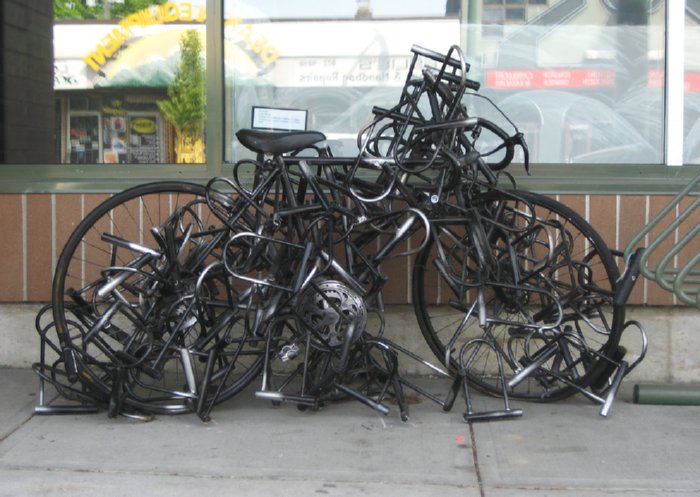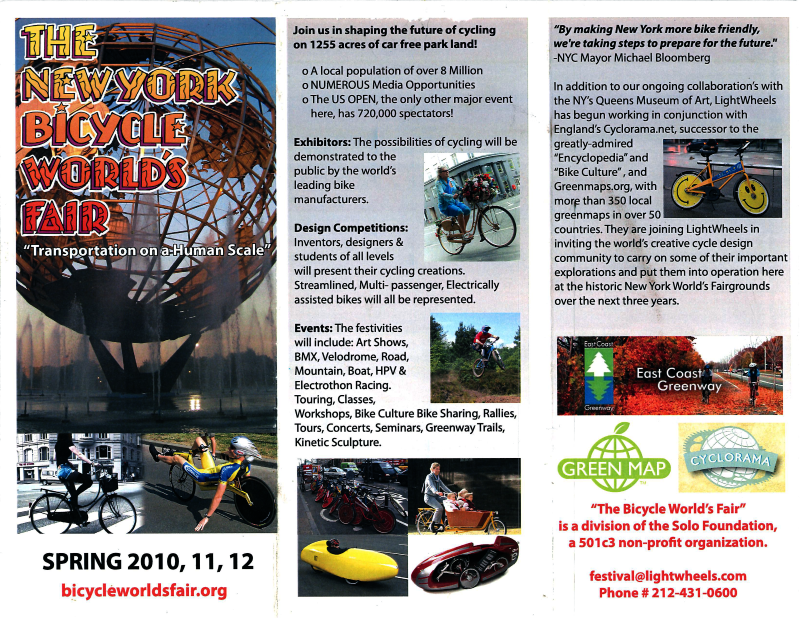A decade ago,
I was the operator of the Boat and Bike rental concession in Flushing Meadows Park, the site of the 1939 and 1964 World’s Fairs. I proposed then that an anniversary celebration of these events be held, but with a different architecture. Instead of large, expensive, and temporary pavilions, sponsored by the biggest corporations, USA States, and foreign governments, the usual top-down affair, it was proposed that this event be a bottom-up, multi-year celebration, centered on creative designs of human-powered and electric-assisted vehicles. Further, it was proposed that these efforts, by individuals or small groups, be supported, in part, by cooperating foundations, companies, cities, and educational institutions, and take place in New York City, as well as in other locations around the world, on an ongoing basis.
Back then, the proposal for these exhibitions and demonstrations was intended to serve to raise the awareness of the potential of these technologies to provide us with their considerable environmental and economic benefits, while developing more interest and involvement in their possibility to contribute to more healthful and needed advances in our ordinary habits. Now, a decade later, after the crucial evolution of battery and motor technology, we are witnessing rapid progress in this realm and every day brings new products and ideas forward. The utility and pleasure provided by these machines have now been established everywhere.
While these developments are certainly welcome, there is still an important opportunity to open this process fully, to engage artists, designers, engineers and mechanics, and others, to contribute to this evolution. Providing a place, like car-free Flushing Meadows Park, to provide one of the central venues for the public to experience these advances, to ride and share these devices and exhibit the results of their creative efforts, will further accelerate their development and wide use.
It is not necessary for any organization to control this activity or directly manage it. Rather, it can be publicized and popularized and become one of the ways for this important technology to become a part of our lives more rapidly and provide for a far wider range of design options. Weather protection, multi-person devices, easier access, and improved safety are some of the areas in which we need to pay more attention. Bicycling is ordinarily a solitary activity and is usually limited to use in fair weather, thus preventing its fullest benefit. The introduction of helper motors has already considerably expanded the number of users, but the most stable, comfortable, and utilitarian models are still rarely available. The ability to use vehicles in all kinds of weather conditions, hot, cold, rainy, etc. limits their ability to replace the multi-ton vehicles that monopolize our open spaces. Multi-passenger “Sociables” that were once popular, is rarely in evidence. All this can change as our ambition to fulfill the potential of these machines is explored and realized.
Recent events, in the form of fires and floods and pandemics, may have been interpreted, by some, as a kind-of Biblical message. For others, this is an urgent call for action, to explore the most dramatic changes in our consumption patterns, of fossil fuels especially, as soon as possible. There are a few changes that will be more effective in countering this challenge to our survival. Creativity is sometimes just a path to pleasure but it can also be a kind of medicine, the most effective response to a dangerous threat. It is time for us to take this remedy to heart, to use the transformation of our public spaces as a conspicuous demonstration of our ability to confront our common challenges and resolve our most serious crises, joyfully and effectively.
A Plan
-
Goals
Environmental
Accelerating needed changes
Introducing new concepts
Widening public awareness
Economic
New companies forming
Money saved
Lessening waste
Lowering costs
Aesthetic
Beauty, not just utility
Uniqueness vs. manufacturing
-
Participants
Designer/Builders
Existing
At schools
Artists/Sculptors
Concepts as well as actualities
Work that excites interest
Organizations
NGOs
Health
Environmental
Justice
Transport
International
Professional
Engineers
Designers
Art
Community
Queens Museum
Hall of Science
Improvement groups
-
International
Foreign Governments
Transportation ministers
Environmental agencies
Health departments
Previous exhibitors
Businesses
Organizations
Comity
Environmental
-
Politicians
NYC
Jessica Ramos
Eric Adams
NYS
Heads of relevant committees
Agencies
NYSERDA
-
Sponsors
Foundations
Personal
Sierra Club
NRDC
Foreign Governments
Transportation ministers
Environmental agencies
Health departments
Previous exhibitors
Industry
Corporations
Former participants
Government Agencies
NRDC
Commerce
DOT
Businesses
Local
Industry-based
Bike-related
Individuals
Stollman
???????
-
Schools
Universities
Community Colleges
High Schools
Trade Schools
-
Strategy
Local buy-in first
Massive email
Request for lists
Public records
Press
Social media
Print and broadcast
Pre-events and exhibits
-
Budget
Minimal $5000 seed money
Primarily volunteers
Outreach through Social Media
Legal setup established
Totally transparent
GoFundMe or other
-
Structure
Democratic, majority-ruled
Members are invited
Temporary initially
Activity aided not managed
-
Supporters
Financial
Signatories
Co-sponsors
-
Staff
Organizer
Media person
Graphic artist
Treasurer
Contacts:
Email: StevenStollman@gmail.com | tel.: 1 212 431 0600
Artwork by Gerard (Baby Jery) Perichon http://babyjery.com/
To download the artwork in a bigger size, please click Picture 1 or Picture 2
or Here for PDF file.

